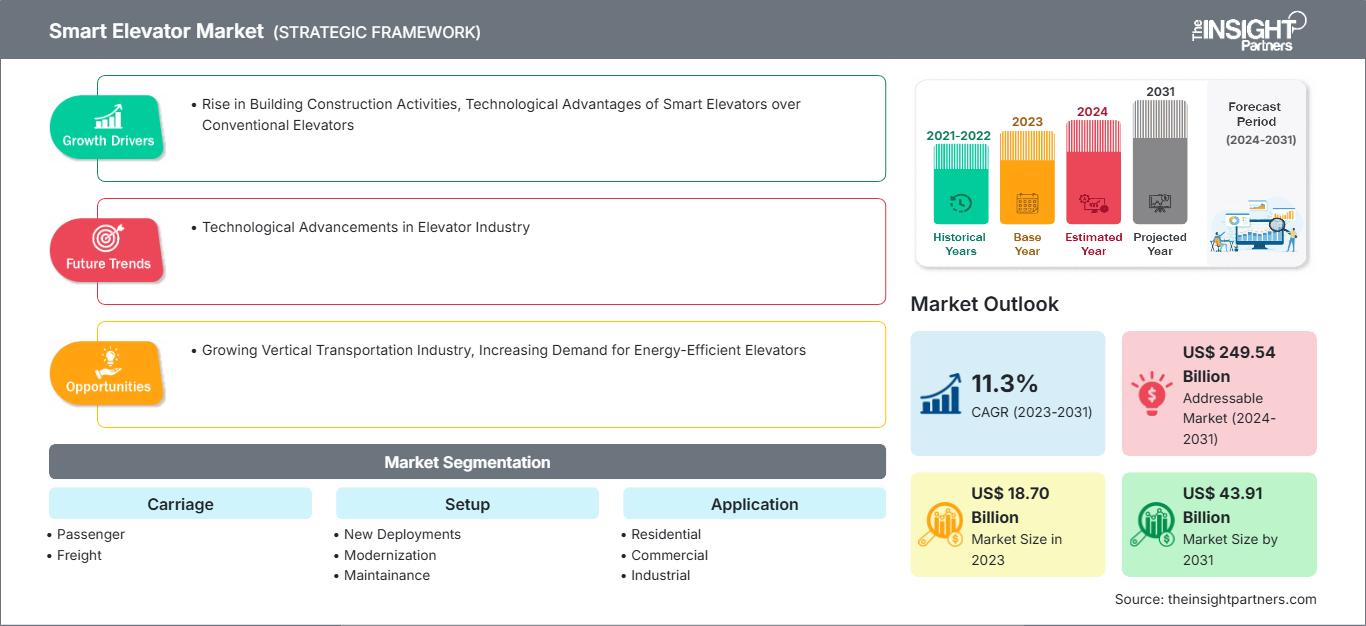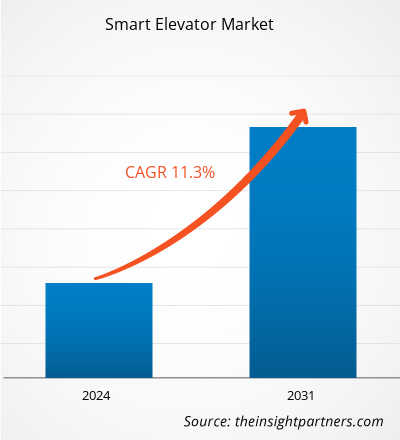Der Markt für intelligente Aufzüge soll von 18,70 Milliarden US-Dollar im Jahr 2023 auf 43,91 Milliarden US-Dollar im Jahr 2031 anwachsen. Für den Zeitraum 2023–2031 wird ein durchschnittliches jährliches Wachstum von 11,3 % erwartet. Technologische Fortschritte und die Einführung neuer Technologien für intelligente Aufzüge werden im Prognosezeitraum voraussichtlich die wichtigsten Markttrends sein.
Marktanalyse für intelligente Aufzüge
Im Gegensatz zu herkömmlichen Aufzügen nutzen intelligente Aufzüge fortschrittliche Sicherheitsmaßnahmen wie Gesichtserkennung, Biometrie und andere Technologien, um unbefugten Zutritt zu verhindern. Darüber hinaus sind in intelligente Aufzüge Sensoren und andere Systeme integriert, die das unregelmäßige Verhalten der Aufzüge, darunter übermäßige Vibrationen, elektrische Fehler und mehr, kontinuierlich überwachen. Daher wird erwartet, dass die Nachfrage nach intelligenten Aufzügen im Prognosezeitraum steigen wird.
Marktübersicht für intelligente Aufzüge
Intelligente Aufzüge sind mit moderner Technologie wie künstlicher Intelligenz (KI), dem Internet der Dinge (IoT), Cloud Computing, Hardware und Software ausgestattet. Zusammen ermöglichen diese Systeme zustandsbasierte Analysen, proaktiven Datenaustausch in Echtzeit, vorausschauende Wartung, verbesserte Sicherheit, Zielvorhersage und weitere Funktionen. Die intelligenten Aufzüge sind benutzerfreundlich, energieeffizient, sicher und weisen minimale Ausfallzeiten auf. Lasten- und Personenaufzüge verfügen über intelligente Funktionen; ein verbessertes Innendesign, Infotainmentsysteme und andere präzise Fahrgastfunktionen sind bei intelligenten Lastenaufzügen jedoch nicht vorhanden.
Markttreiber und -chancen für intelligente Aufzüge
Passen Sie diesen Bericht Ihren Anforderungen an
Sie erhalten kostenlos Anpassungen an jedem Bericht, einschließlich Teilen dieses Berichts oder einer Analyse auf Länderebene, eines Excel-Datenpakets sowie tolle Angebote und Rabatte für Start-ups und Universitäten.
Markt für intelligente Aufzüge: Strategische Einblicke

- Holen Sie sich die wichtigsten Markttrends aus diesem Bericht.Dieses KOSTENLOSE Beispiel umfasst Datenanalysen, die von Markttrends bis hin zu Schätzungen und Prognosen reichen.
Sie erhalten kostenlos Anpassungen an jedem Bericht, einschließlich Teilen dieses Berichts oder einer Analyse auf Länderebene, eines Excel-Datenpakets sowie tolle Angebote und Rabatte für Start-ups und Universitäten.
Markt für intelligente Aufzüge: Strategische Einblicke

- Holen Sie sich die wichtigsten Markttrends aus diesem Bericht.Dieses KOSTENLOSE Beispiel umfasst Datenanalysen, die von Markttrends bis hin zu Schätzungen und Prognosen reichen.
Zunahme im Hochbau und steigende Nachfrage nach umweltfreundlichen Gebäuden begünstigen den Markt
Der Aufschwung im Hochbau und die steigende Nachfrage nach umweltfreundlichen Gebäuden sind wichtige Treiber für das Wachstum des Marktes für intelligente Aufzüge. Die steigende Nachfrage nach diesen Aufzügen ist zudem auf verschiedene Merkmale zurückzuführen, die sie von herkömmlichen Aufzügen unterscheiden. Herkömmliche Aufzüge sind ineffizient, da ihre grundlegende Rechenleistung die Wartezeit der Benutzer nicht verkürzen kann. Darüber hinaus sind sie im Vergleich zu modernen Aufzügen nicht energieeffizient und verfügen nicht über eine Echtzeitüberwachung des Aufzugssystems. Intelligente Aufzüge hingegen sind technisch fortschrittlich und verfügen über verschiedene Funktionen, die ihre Anwendung bei Bauunternehmen begünstigen. Der Einsatz autonomer Systeme in diesen Aufzügen trägt zur Optimierung des Aufzugsbetriebs bei, was wiederum die Wartezeit verkürzt und letztendlich zu einem effektiven Personentransport während der Stoßzeiten führt. Daher wird die Nachfrage nach intelligenten Aufzügen im Prognosezeitraum voraussichtlich steigen.
Segmentierungsanalyse des Marktberichts für intelligente Aufzüge
Die „Analyse intelligenter Aufzüge“ Die Analyse erfolgte unter Berücksichtigung der folgenden Segmente: Aufbau, Beförderung, Anwendung und Geografie.
- Der Markt für intelligente Aufzüge ist in Modernisierung, Neuinstallation und Wartung unterteilt. Im Jahr 2022 dominierte das Modernisierungssegment den Marktanteil gemessen am Umsatz, und für das Wartungssegment wird im Prognosezeitraum eine beträchtliche jährliche Wachstumsrate prognostiziert. Das Modernisierungssegment umfasst die Installation neuer Systeme in einem alten Aufzugssystem, um es zu modernisieren. Im Laufe der Zeit werden sich die gesetzlichen und technischen Richtlinien der Gebäude wahrscheinlich ändern; daher müssen zahlreiche Einrichtungen, einschließlich Aufzüge, modernisiert werden. Mit Modernisierungsdiensten verfügen herkömmliche Aufzüge über Funktionen wie cloudbasierte Lösungen für vorausschauende Wartung, Echtzeitüberwachung, verbesserte Benutzeroberflächen und Infotainmentsysteme sowie mehr Sicherheit.
- Zusätzlich umfasst das Wartungssegment die Instandhaltung bereits vorhandener Aufzüge in einem Gebäude. Regelmäßige Wartung intelligenter Aufzüge verlängert die Lebensdauer des Aufzugs und vermeidet ungeplante Ausfälle.
- Bezüglich der Beförderung ist der Markt für intelligente Aufzüge in Personen- und Güteraufzüge unterteilt. Der Markt ist nach Anwendung in Wohn-, Gewerbe- und Industriebereiche unterteilt.
Geografische Analyse der Marktanteile intelligenter Aufzüge
Der geografische Umfang des Marktberichts für intelligente Aufzüge ist hauptsächlich in fünf Regionen unterteilt: Nordamerika, Asien-Pazifik, Europa, Naher Osten und Afrika sowie Süd- und Mittelamerika.
Im Jahr 2022 hatte Nordamerika den größten Marktanteil für intelligente Aufzüge. Es wird jedoch geschätzt, dass der Asien-Pazifik-Raum im Prognosezeitraum die höchste durchschnittliche jährliche Wachstumsrate (CAGR) verzeichnet. Die USA und Kanada sind wohlhabende Nationen mit einem hohen städtischen Lebensstandard. Darüber hinaus ist die Implementierungsrate neuer und neuester Technologien in allen nichtindustriellen und industriellen Sektoren vergleichsweise höher als in anderen Teilen der Welt, was die Nachfrage nach Aufzügen in Gebäuden voraussichtlich ankurbeln wird. Neuartige Bauweisen und die zunehmende Verfügbarkeit hoher Gebäude spielen eine wichtige Rolle bei der Förderung des Wachstums des Marktes für intelligente Aufzüge in den Bereichen Neuinstallation sowie Modernisierung und Wartung in Nordamerika.
Darüber hinaus ist die hohe durchschnittliche jährliche Wachstumsrate (CAGR) im asiatisch-pazifischen Raum auf ein breites Wirtschaftswachstum und einen Anstieg der Urbanisierung und Bevölkerung in Ländern wie Indien, China, Indonesien und Vietnam zurückzuführen. Die Weltbevölkerung hat in den letzten Jahren erheblich zugenommen und wird in den kommenden Jahren voraussichtlich stark ansteigen. Laut Prognosen der Vereinten Nationen erreichte die Weltbevölkerung Ende 2022 8 Milliarden Menschen und soll bis 2030 auf 8,5 Milliarden ansteigen. Bis 2050 soll sie sogar auf 9,7 Milliarden ansteigen. Afrika und Asien, insbesondere Länder wie China und Indien, werden Schätzungen zufolge in den nächsten 30 Jahren maßgeblich zur zunehmenden Urbanisierung beitragen. Diese Faktoren werden die Marktprognose für intelligente Aufzüge in den nächsten Jahren voraussichtlich erheblich beeinflussen.
Marktneuigkeiten und aktuelle Entwicklungen im Bereich intelligenter Aufzüge
Der Markt für intelligente Aufzüge wird durch die Erhebung qualitativer und quantitativer Daten aus Primär- und Sekundärforschung bewertet, die wichtige Unternehmenspublikationen, Verbandsdaten und Datenbanken umfasst. Im Folgenden finden Sie eine Liste der Marktentwicklungen:
- Im Dezember 2022 kündigte Otis die Einführung eines neuen intelligenten Aufzugs der dritten Generation mit rund um die Uhr verfügbarer Echtzeitüberwachung der Aufzugsleistung an. (Quelle: Otis Corporation, Pressemitteilung)
Intelligenter AufzugRegionale Einblicke in den Markt für intelligente Aufzüge
Die Analysten von The Insight Partners haben die regionalen Trends und Faktoren, die den Markt für intelligente Aufzüge im Prognosezeitraum beeinflussen, ausführlich erläutert. In diesem Abschnitt werden auch die Marktsegmente und die geografische Lage in Nordamerika, Europa, dem asiatisch-pazifischen Raum, dem Nahen Osten und Afrika sowie Süd- und Mittelamerika erörtert.
Umfang des Marktberichts zu intelligenten Aufzügen
| Berichtsattribut | Einzelheiten |
|---|---|
| Marktgröße in 2023 | US$ 18.70 Billion |
| Marktgröße nach 2031 | US$ 43.91 Billion |
| Globale CAGR (2023 - 2031) | 11.3% |
| Historische Daten | 2021-2022 |
| Prognosezeitraum | 2024-2031 |
| Abgedeckte Segmente |
By Beförderung
|
| Abgedeckte Regionen und Länder | Nordamerika
|
| Marktführer und wichtige Unternehmensprofile |
|
Dichte der Marktteilnehmer für intelligente Aufzüge: Verständnis ihrer Auswirkungen auf die Geschäftsdynamik
Der Markt für intelligente Aufzüge wächst rasant. Die steigende Nachfrage der Endnutzer ist auf Faktoren wie veränderte Verbraucherpräferenzen, technologische Fortschritte und ein stärkeres Bewusstsein für die Produktvorteile zurückzuführen. Mit der steigenden Nachfrage erweitern Unternehmen ihr Angebot, entwickeln Innovationen, um den Bedürfnissen der Verbraucher gerecht zu werden, und nutzen neue Trends, was das Marktwachstum weiter ankurbelt.

- Holen Sie sich die Markt für intelligente Aufzüge Übersicht der wichtigsten Akteure
Bericht zum Markt für intelligente Aufzüge: Umfang und Ergebnisse
Der Bericht „Marktgröße und -prognose für intelligente Aufzüge (2023–2031)“ bietet eine detaillierte Analyse des Marktes und deckt die folgenden Bereiche ab:
- Marktgröße und -prognose auf globaler, regionaler und Länderebene für alle abgedeckten wichtigen Marktsegmente
- Marktdynamik wie Treiber, Einschränkungen und wichtige Chancen
- Wichtige zukünftige Trends
- Detaillierte PEST/Porters Fünf-Kräfte- und SWOT-Analyse
- Globale und regionale Marktanalyse mit wichtigen Markttrends, wichtigen Akteuren, Vorschriften und aktuellen Marktentwicklungen
- Branchenlandschaft und Wettbewerbsanalyse mit Marktkonzentration, Heatmap-Analyse, prominenten Akteuren und aktuellen Entwicklungen
- Detaillierte Unternehmensprofile
- Historische Analyse (2 Jahre), Basisjahr, Prognose (7 Jahre) mit CAGR
- PEST- und SWOT-Analyse
- Marktgröße Wert/Volumen – Global, Regional, Land
- Branchen- und Wettbewerbslandschaft
- Excel-Datensatz
Aktuelle Berichte
Erfahrungsberichte
Grund zum Kauf
- Fundierte Entscheidungsfindung
- Marktdynamik verstehen
- Wettbewerbsanalyse
- Kundeneinblicke
- Marktprognosen
- Risikominimierung
- Strategische Planung
- Investitionsbegründung
- Identifizierung neuer Märkte
- Verbesserung von Marketingstrategien
- Steigerung der Betriebseffizienz
- Anpassung an regulatorische Trends




















 Kostenlose Probe anfordern für - Markt für intelligente Aufzüge
Kostenlose Probe anfordern für - Markt für intelligente Aufzüge